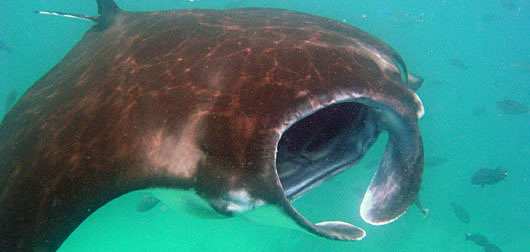Manta Rays: Sangalaki Island
The currents around Sangalaki apparently concentrate plankton and small crustaceans to the extent that the waters become a genuine larder for hungry manta rays – all year round according to everybody we asked. When we probed a bit the locals did admit that there had been a three months' period four years ago when the mantas suddenly disappeared. That would have been in 1998, and a fair guess would be that El Niño also took his toll here like so many places in the Indian and Pacific Oceans.
The dive site Manta Cleaning Station has a maximum depth of approx. 15 metres. There is a “runway” of sand surrounded by coral pinnacles and bommies that goes parallel to the current. We didn't fancy getting stuck in table corals or knocking large fans about so our only option was to sit ourselves down on the sandy bottom on the runway with our backs against the current and our heels placed firmly in the sand. It looked silly but it worked.
In this way we slowly but surely slid along the bottom towards to cleaning station. We got really close after a while and saw a couple of huge mantas descend upon a rock and make themselves available to literally every kind of small fish in the neighbourhood. One of the mantas was cleaned inside out by gobies, bannerfish and wrasse.
And there we were. In the middle of what could best be described as a manta ray feeding frenzy. We were at any given time surrounded by at least 6 or 8 mantas. The smaller ones reached some 1.5 metres across the wings and the larger ones about 4-4.5 m. They all kept on filter feeding quite oblivious to our presence, and some of them came so close that their wings brushed against us. Really, really, really awesome.
We got just a teeny-weeny bit paranoid by all those big hungry mouths incessantly coming towards us from all directions. Only at the very last second did they turn away and went either below us or to the left or right of us.
Usually manta rays have black backs and a white bellies. But here we also saw quite large mantas that were totally black. Our dive guide called them Darth Vaders, which seemed like a fair description. In all we managed to get five dives around Sangalaki Island – not forgetting the coolest snorkelling trip ever.

Hungry Giant manta ray at Sangalaki Island
